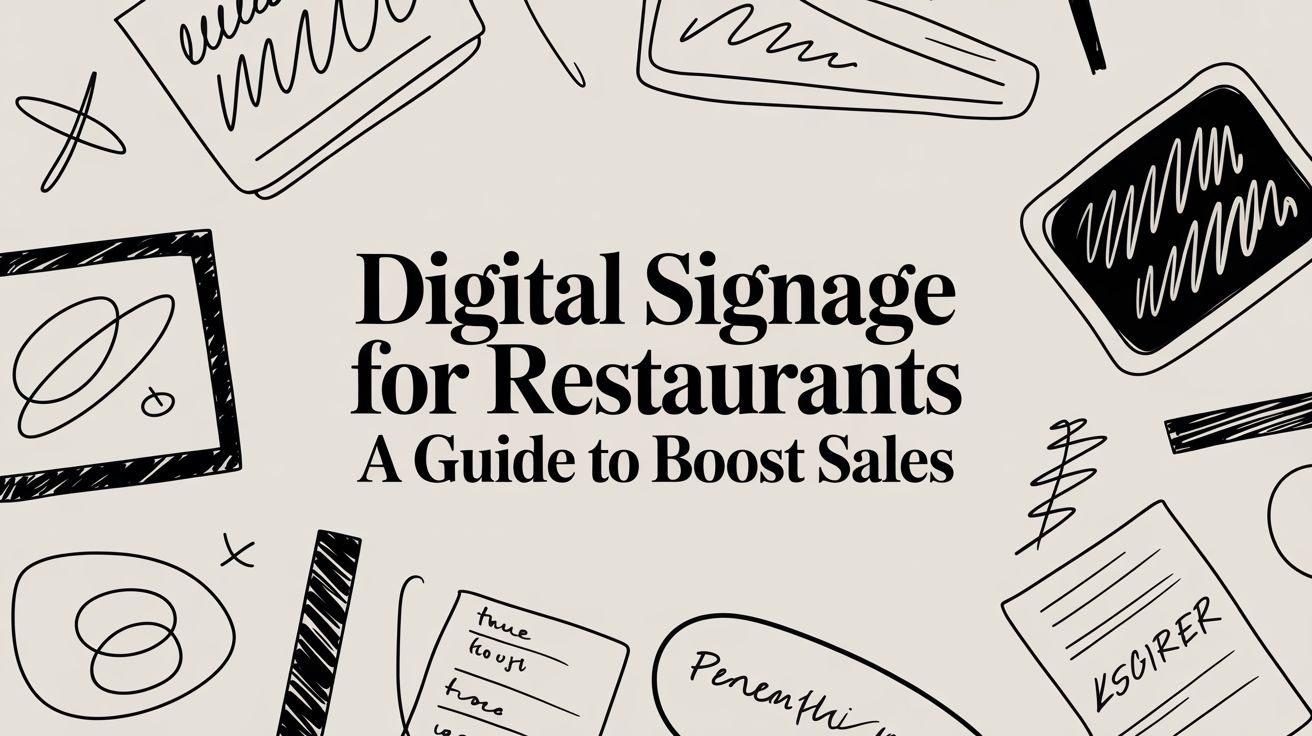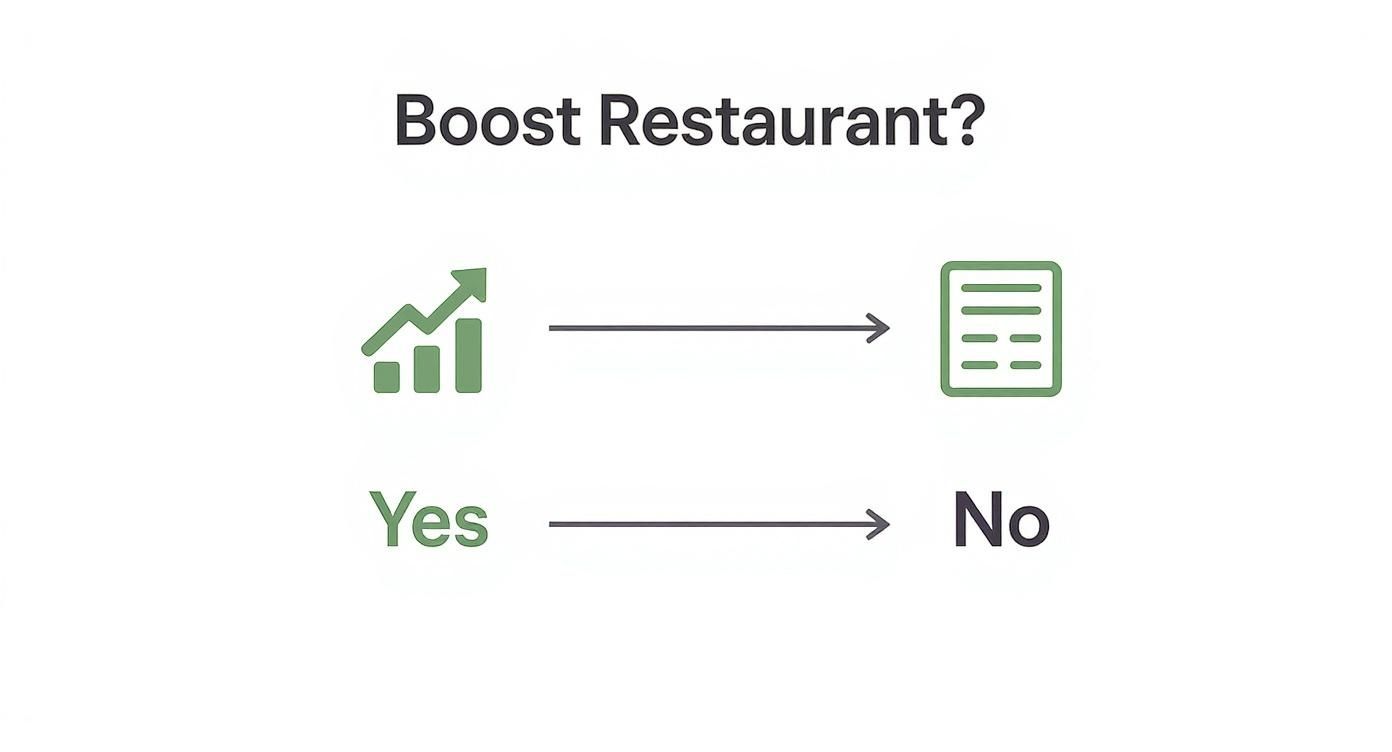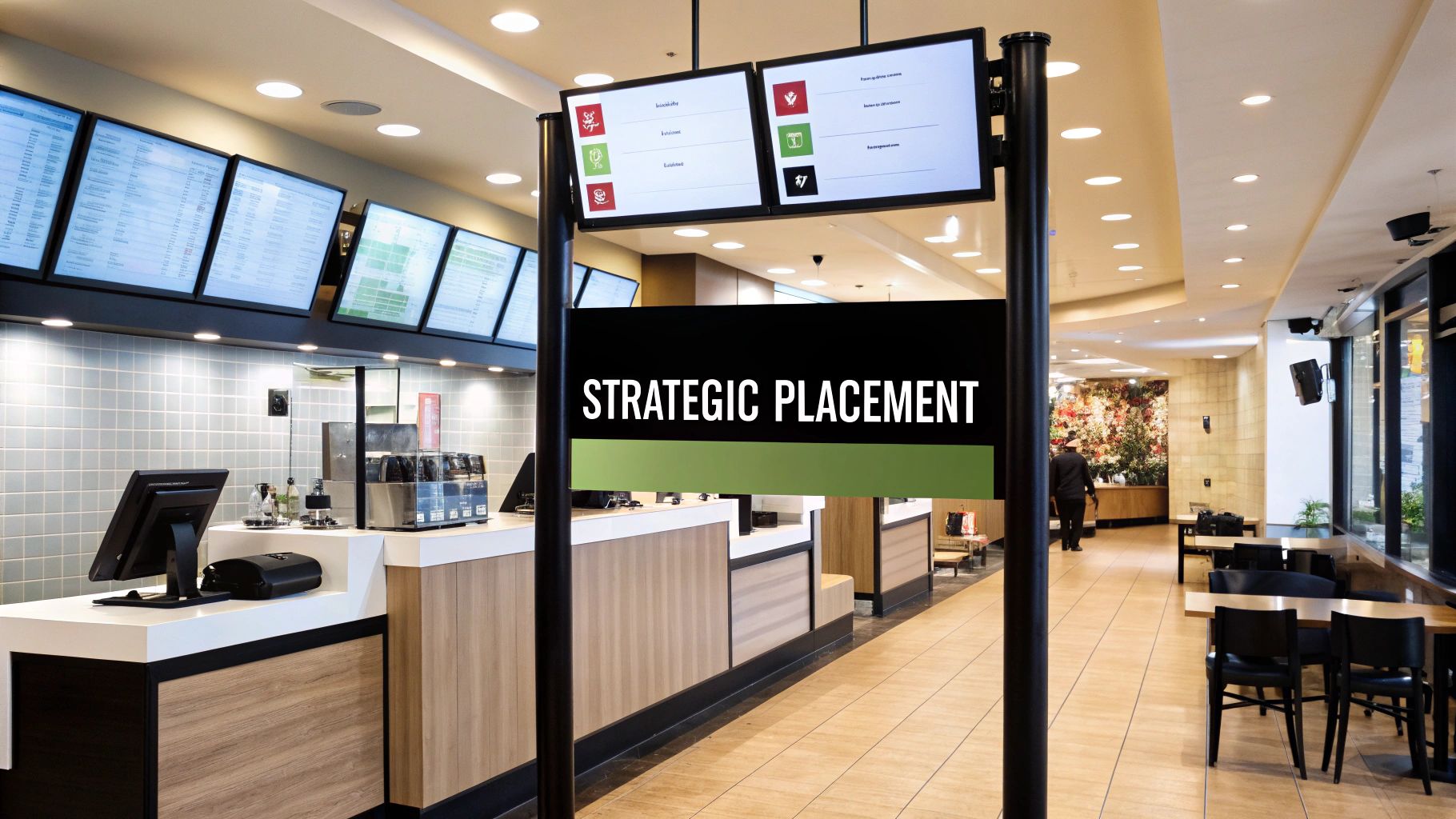
Ultimate Roll Up LED Display Guide
A roll up LED display feels like a high-resolution screen you can stash in a poster tube. In a few seconds, it unfurls into a

Imagine if your restaurant's walls could talk. What would they say? They could tell stories about your most popular dishes, announce the chef's daily specials, and create an atmosphere that guests remember long after they've left. That’s the real magic behind digital signage for restaurants. This isn't just about swapping out posters for screens; it's about giving your restaurant a voice.
At its core, digital signage is any screen showing content meant to inform, entertain, or persuade. For a restaurant, it’s the difference between a paper menu that's instantly outdated and a vibrant, digital menu board you can update in seconds. It’s a tool that goes way beyond just listing prices—it crafts an entire experience.
Instead of relying on paper flyers that usually end up in the trash, restaurants are now using screens to grab a customer's attention the second they walk through the door. This isn't just about looking modern; it's about driving tangible business results. The technology lets you showcase mouth-watering videos of your signature dishes, automatically flip from a breakfast to a lunch menu, and even strategically promote high-margin items to boost your average check size.
Adopting digital screens is far more than a trend. It's a strategic move with a clear return on investment. The global digital signage market for restaurants is proof, with projections showing it will hit roughly $1.6 billion by 2034, growing at a steady clip of 7.7% each year. This growth is being driven by restaurant owners who are seeing the benefits firsthand.
The most obvious advantages are in efficiency and customer engagement. Just think about the time and money you save by not having to print and replace paper menus every time a price changes or you run a new special. Now, imagine using that same screen to display customer-generated social media posts, building a sense of community and providing powerful social proof right inside your four walls.
Digital signage gives restaurants a direct line of communication with their customers at the most critical moment—when they are deciding what to order. It transforms a passive waiting experience into an active, engaging, and profitable interaction.
To give you a clearer picture, here’s a quick rundown of the core benefits.
| Key Benefit | How It Helps Your Restaurant | Example Application |
|---|---|---|
| Increased Sales | Promotes high-margin items and add-ons with tempting visuals. | A video of a steaming-hot pizza paired with a craft beer special. |
| Enhanced Ambiance | Creates a specific mood with curated visuals and brand stories. | A fine-dining spot showing artistic food prep videos. |
| Operational Efficiency | Instantly update menus, prices, and promotions across all locations. | Switching from the breakfast to lunch menu with a single click. |
| Reduced Wait Times | Keeps customers entertained and informed while they wait. | Displaying trivia, fun facts, or order status updates. |
| Stronger Brand | Reinforces your brand identity with consistent, professional messaging. | Using brand colors, fonts, and logos across all on-screen content. |
These benefits work together to create a more dynamic and profitable environment, turning a simple meal into a memorable experience.
While digital menu boards are often the first thing people think of, the technology’s true power lies in its versatility. It can be used for everything from captivating window displays that pull pedestrians inside to screens in waiting areas that make wait times feel shorter. A well-placed screen can entertain guests with trivia or share your brand's story, making their wait feel both shorter and more enjoyable.
Restaurants are also using these displays for:
This incredible adaptability makes digital signage a cornerstone of modern restaurant operations. Even the visuals you use for marketing outside your restaurant can be optimized. Check out our guide on effective digital outdoor signage to learn how to capture attention before customers even step foot inside. By understanding these foundational benefits, you can start to see how this technology serves as a powerful tool to build a more engaging and profitable restaurant.
Picking the right tech for your restaurant's digital signage is a lot like choosing the perfect ingredients for a signature dish. The hardware—the screens themselves—and the software that runs them have to work together seamlessly. Get it right, and you create a fantastic experience for your customers and a smooth, efficient workflow for your team.
Think of the hardware as the physical presence of your brand. It’s what your customers actually see and engage with. Your choice here comes down to what job you need the screen to do, from a mouth-watering indoor menu board to a tough, eye-catching outdoor display that grabs the attention of people walking by.
When you're looking at hardware, two things matter most: resolution and brightness. You’ve probably seen terms like HD (1080p) or 4K (Ultra HD)—that’s resolution, and it determines how sharp and clear your images and text look. For something customers view up close, like a menu board, 4K is usually worth the investment to make every detail of your food photography pop.
Brightness, measured in nits, is just as important. A screen inside a cozy, dimly lit dining room doesn't need to be nearly as bright as one in a window competing with direct sunlight. Outdoor screens need the absolute highest nit ratings to stay visible and are built tough to handle whatever the weather throws at them. Making the right call here ensures your content always looks exactly how you intended.
This decision tree lays out how investing in dynamic digital signage directly fuels your restaurant's growth, leaving static options in the dust.

As you can see, the path to boosting your restaurant's performance is paved with dynamic content that leads directly to real, measurable sales growth.
Choosing the right screen for the right spot is crucial for both performance and budget. This table breaks down the most common types to help you decide.
| Display Type | Best Use Case | Key Considerations (Brightness, Durability) | Typical Price Range |
|---|---|---|---|
| Indoor Menu Boards | Above the counter for ordering, displaying daily specials. | Lower brightness (350-700 nits) is fine. Focus on high resolution (4K) for crisp text and images. | $$ – $$$ |
| Window-Facing Displays | Attracting foot traffic from outside. | High brightness is critical (2,500+ nits) to overcome sun glare. Must have good cooling systems. | $$$ – $$$$ |
| Outdoor Displays | Drive-thru menus, curbside pickup, building exteriors. | Very high brightness (3,000+ nits) and weatherproof (IP65+ rating). Extremely durable. | $$$$ – $$$$$ |
| Video Walls | Creating a "wow" factor in waiting areas or behind the bar. | Moderate brightness, but seamless bezels are key for a unified image. Color accuracy is important. | $$$$ – $$$$$ |
Ultimately, a mix-and-match approach often works best—a stunning video wall to set the mood, sharp 4K menu boards for easy ordering, and a super-bright window display to pull people in off the street.
If the hardware is the body, the software is the brain. The Content Management System (CMS) is what lets you control everything that shows up on your screens. A good CMS makes managing your digital signage simple and intuitive, even for staff who aren't tech-savvy.
This is where you'll upload your best food photos, design menus, and schedule promotions. The best systems today are cloud-based, which means you can log in from any computer and update all your screens in an instant—whether you have one location or a hundred. It completely removes the headache of updating things manually and gives you the agility to react on the fly.
A powerful yet user-friendly CMS is the most critical component of a successful digital signage strategy. It transforms your screens from static displays into a dynamic sales and marketing tool that you can control with a few clicks.
When you’re picking a CMS, keep an eye out for these game-changing features:
These core features ensure your digital signage system is a workhorse, not a complicated burden. Finding a provider that offers a range of high-quality LED signs for businesses alongside intuitive software guarantees a setup that’s both cohesive and effective. In the end, the right mix of hardware and software will turn your digital signage into one of your hardest-working employees.

Putting up a high-quality screen is only half the battle. The real magic of digital signage for restaurants happens when you pair that great hardware with content that truly connects with your customers. Think of your displays as a blank canvas—what you put on them directly shapes your diners' decisions and, ultimately, your bottom line.
The goal here isn't just to list menu items. It's to tell a story, spark an appetite, and make the ordering process effortless.
It all starts with solid digital menu design. Ditch the cluttered layouts and text that's impossible to read from a distance. Your menu needs to be clean, organized, and instantly understandable. High-contrast colors and typography that match your brand are great, but readability should always be your top priority. A well-designed digital menu cuts down on confusion and speeds up ordering, which is a lifesaver during those crazy busy shifts.
Let's be honest: we eat with our eyes first. This is where professional, high-resolution food photography becomes your single most powerful sales tool. Grainy, poorly lit photos of your dishes can do more harm than good, making even your most incredible food look completely unappetizing.
It’s absolutely critical to understand how to take food photos that drive restaurant sales. Invest in photography that makes your food jump off the screen, with vibrant colors and textures that look so good you can almost taste them. These images aren't just for decoration; they're strategic assets you can use to draw eyes to your most profitable or popular dishes.
A single, stunning image of your signature burger can be far more persuasive than a dozen lines of descriptive text. Visuals tap into emotion and desire, making them an essential part of any content strategy.
And why stop at static images? Short video clips can be incredibly effective. Imagine showing a time-lapse of a pizza being made, a sizzling steak getting plated, or a bartender crafting a colorful cocktail. This kind of dynamic content grabs attention and creates a sensory experience that a simple picture just can't match.
One of the biggest wins with digital signage is the ability to show the right message at exactly the right time. This is where a simple but brilliant strategy called dayparting comes in. Dayparting is just the practice of scheduling your content to change automatically throughout the day, so your screens are always relevant to who’s in your restaurant.
This simple tactic lets you do things like:
Dayparting ensures your promotions are perfectly timed for maximum impact, helping you make the most of every hour you're open. It streamlines things for your staff and creates a much more tailored experience for your guests.
A digital screen showing the same thing for weeks on end is just a very expensive poster. To get real, long-term results, you need to keep your displays fresh, engaging, and even a little interactive. The good news is, modern systems make it easy to pull in dynamic content that keeps customers looking.
Think about integrating a live social media feed that shows off Instagram posts from happy customers using your restaurant's hashtag. That’s powerful social proof and helps build a sense of community right there on your screen. Another great move is to create urgency for limited-time offers with a countdown timer. Watching the clock tick down on a "deal of the day" can be a powerful nudge for someone to make an impulse buy.
These strategies are quickly becoming essential in modern restaurant operations. Digital menu boards are a fast-growing part of the hospitality digital signage market, which was valued at USD 2,478.2 million in 2024. And with research showing that digital menus can boost average sales by 3% to 30%, the incentive to create dynamic, mouth-watering content is crystal clear.

Let's be clear: where you put your digital screens is just as important as the mouth-watering content you show on them. Think of your restaurant layout as a customer journey. Each screen should pop up like a helpful guide at just the right moment, shaping decisions and making the whole experience better.
A screen thrown onto a wall without much thought is just noise. But one that's placed with intention? That’s a powerful sales tool.
The whole point is to get your signage where it will grab the most eyeballs and deliver real value. This means walking a mile in your customers' shoes, tracing their natural path from the front door to their table and back out again. A screen that’s too high, too low, or hiding behind a ficus plant might as well not even be there.
Every single area in your restaurant is a unique opportunity to talk to your guests. What you say at the entrance should feel totally different from what you display over the counter. Getting a handle on these zones is the first real step to building a powerful visual network in your space.
Let’s break down the four most critical zones for digital signage:
Once you've mapped out your key zones, it's time to fine-tune. It's not enough to just hang a screen on a wall—it needs to be positioned for effortless viewing. Think about viewing angles. A screen should be at eye level for the average person, whether they're standing in line or sitting at a table.
Glare is the mortal enemy of digital signage. Before you drill any holes, check for reflections from overhead lights or windows at different times of the day. Sometimes, all it takes is a slight tilt or a different mounting bracket to kill that distracting glare and make your content perfectly readable.
A clean, professional installation signals quality and attention to detail—the same values you want people to associate with your food and service. Messy cables or crooked screens can cheapen the entire vibe.
Finally, never underestimate the power of a polished setup. Hiding the cables, using secure mounts, and making sure screens are flush with the wall all contribute to a premium, thought-out look. For bigger spaces, you can create a truly immersive atmosphere with seamless, bezel-less screens that melt into one another.
You can learn more about how to create these stunning visual centerpieces by exploring the latest in Smart LED indoor LED wall panels. This kind of attention to detail ensures your tech actually enhances your restaurant's ambiance instead of distracting from it.
Investing in new tech for your restaurant always boils down to one simple question: is it worth it? With digital signage for restaurants, the answer isn't just a hopeful "yes"—it's something you can actually measure and prove.
Calculating your return on investment (ROI) is what turns your screens from a cool, flashy feature into a genuine business asset. Think of it like a recipe: the initial cost of your hardware and software is the main ingredient. The results—like a bump in sales and lower operational costs—are the delicious final dish. The goal is to prove that what you get out is far more valuable than what you put in.
To measure success, you first need to define what it looks like. Key Performance Indicators (KPIs) are the specific, trackable metrics that tell you exactly how your digital signage is performing. Instead of just guessing, you get to focus on real data you already have.
The best part? You don't need fancy, complicated tools to start tracking. Most of this info is sitting right inside your Point-of-Sale (POS) system.
Start by zeroing in on these three high-impact KPIs:
Once you know your KPIs, calculating your ROI is pretty straightforward. You're just weighing your initial investment against the financial gains and savings it generates over time. This gives you a clear, data-backed business case for your digital signage.
The formula is simple: (Financial Gain – Investment Cost) / Investment Cost = ROI.
To figure out your financial gain, just add up the new revenue and the savings your screens created. This includes the extra sales from promoted items and the money you saved by ditching printed paper menus, posters, and flyers for good.
The power of digital signage in restaurants is backed by some seriously compelling data on customer behavior. Research shows that a whopping 80% of customers walk into a store because a digital display caught their eye, and 19% make impulse buys directly because of them. You can discover more about these powerful statistics and how they impact businesses.
This framework gives you a concrete percentage that proves the value of your investment. It’s the perfect way to show that your digital signage for restaurants isn't an expense—it’s a revenue-generating engine that pays for itself.
Diving into the world of digital signage for your restaurant is exciting, but it naturally brings up a few questions. To help you feel confident moving forward, we’ve put together straightforward answers to the most common queries we hear from restaurant owners just like you.
Think of this as your no-nonsense guide to getting started.
The honest answer? It really depends on what you’re trying to achieve. A simple setup for a single cafe—maybe a couple of screens and basic software—could start in the low thousands. On the other hand, a full-scale rollout for a multi-location chain with custom video walls and sophisticated software is a much larger investment.
The price tag is really driven by a few key things:
A good rule of thumb is to budget for hardware, software, installation, and content creation as four separate pieces of the puzzle.
Absolutely. This is one of the best parts. Modern digital signage systems are designed for busy restaurant owners, not IT wizards. Most Content Management Software (CMS) platforms have a simple web-based dashboard you can log into from any computer to make changes on the fly.
That means you can easily swap out menu items, tweak prices, highlight daily specials, or schedule a happy hour promotion to pop up automatically at 4 PM. Many systems even come with pre-built templates, so you can create beautiful, professional-looking content without having to call a graphic designer for every little update.
The complexity of the installation really boils down to your vision. Hanging a single screen on a standard wall mount is pretty straightforward. But if you’re dreaming of a massive video wall or a weatherproof outdoor display, you’ll want to bring in the pros to handle the wiring, secure mounting, and weatherproofing correctly.
When it comes to upkeep, the software side is a breeze—it’s typically managed by your provider with automatic updates. For the hardware, it's usually just a matter of wiping the screens down and making sure they have enough airflow to stay cool.
Choosing a provider with a reputation for solid customer support is the real secret to a headache-free experience from day one.
We've seen a few common missteps over the years. The biggest ones are using blurry, low-quality images, cramming too much text onto the screen, and letting the content get stale. A digital screen that shows the same thing for six months is no better than a faded paper poster.
Other pitfalls include placing screens where customers can’t easily see them or picking a system that’s way too complicated for your staff to actually use. To get it right, just remember to focus on simplicity, quality, and consistency.
Ready to bring your restaurant's atmosphere to life and see your sales climb? The expert team at Smart LED Inc. can help you design and install the perfect digital signage solution for your unique space. Explore our high-impact displays and get a custom quote today at smartledinc.com.

A roll up LED display feels like a high-resolution screen you can stash in a poster tube. In a few seconds, it unfurls into a

So, you're thinking about a video wall. The big question on everyone's mind is always: what's this actually going to cost? The honest answer is,

Think about the walls around you. For most of history, they’ve been static, passive surfaces. But what if a wall could come alive? What if
"*" indicates required fields